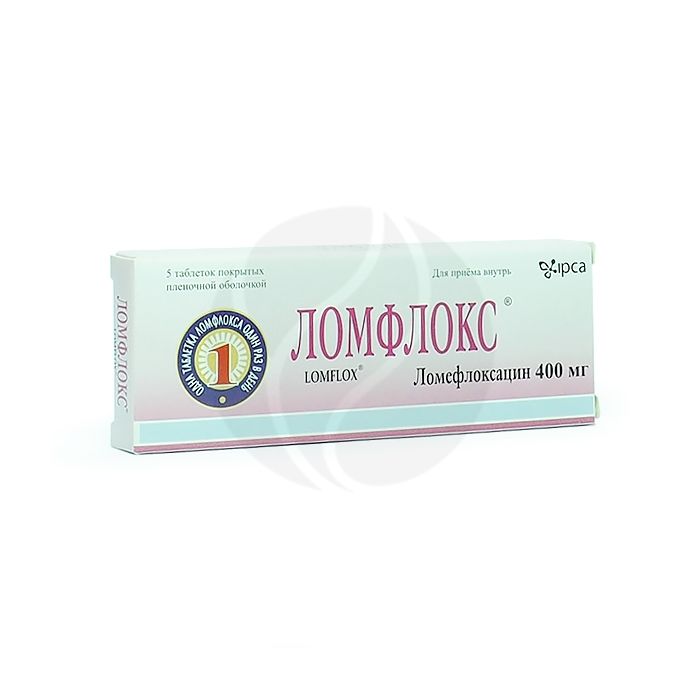Lomflox tablets 400mg, No. 5
Expiration Date: 05/2027
Russian Pharmacy name:
Ломфлокс таблетки 400мг, №5
Infectious and inflammatory diseases caused by microorganisms sensitive to lomefloxacin:
infections of the lower respiratory tract (including exacerbation of chronic bronchitis and pneumonia);
otitis media;
uncomplicated and complicated infections of the genitourinary system;
acute and chronic gonococcal, chlamydial and mixed infections; infections of the skin and soft tissues;
infections of bones and joints (including chronic osteomyelitis);
infectious enterocolitis and cholecystitis; pulmonary tuberculosis (acutely progressive forms of tuberculosis, multidrug resistance of mycobacteria, poor tolerance of rifampicin, tuberculosis and concomitant nonspecific inflammatory processes);
Prevention of infectious complications during transurethral surgery.
The reception mode is individual.
Inside (regardless of food intake, drinking plenty of fluids), 400 mg 1 time / day. In case of impaired renal function on the first day, 400 mg, then 200 mg / day. The dose and duration of the course depend on the severity of the disease and the sensitivity of the pathogen.
Film-coated tablets
1 tab.
Lomefloxacin (in the form of hydrochloride) 400 mg
Excipients: lactose, starch, polyvinylpyrrolidone, sodium starch glycolate, crospovidone, purified talc, sodium lauryl sulfate, magnesium stearate, propylene glycol, colloidal silicon dioxide.
cerebral atherosclerosis, epilepsy and other conditions with a predisposition to seizures;
pregnancy, lactation;
children under 15 years of age;
hypersensitivity to lomefloxacin and other quinolones.
pharmachologic effect
Lomefloxacin is a synthetic antimicrobial drug of the fluoroquinolone group with a broad spectrum of bactericidal action. Blocks bacterial DNA gyrase, forming a complex with its tetramer and disrupts DNA transcription and replication, leads to the death of a microbial cell. It is active against gram-negative and gram-positive microorganisms: gram-negative aerobes (Citrobacter diversus and freundii, Enterobacter cloacaae, aerogenes and agglomerans, Escherichia coli, Haemophilus influenzae, parainfluenzae, Klebsiella aerurabiu, Pneumonia, Pneumonia, Oxytoca, Proteinella vulgarea , Morganella morganii, Legionella pneumophilla, Salmonella spp., Shigella spp., Providencia rettgeri, Serratia liquefaciens and marcescens, Neisseria gonorrhoeae, Neisseria meningitidis),gram-positive aerobes (Staphylococcus saprophyticus, aureus and epidermidis), chlamydia, mycobacterium tuberculosis (both extra- and intracellular), some strains of mycoplasma and uroplasma. In an acidic environment, efficiency decreases, resistance develops slowly. Has a pronounced postantibiotic effect. Streptococci (most groups A, B, D, G), Streptococcus pneumoniae, Pseudomonas cepacia, Ureaplasma urealyticum, Mycoplasma hominis and anaerobes are resistant to the action of lomefloxacin.G), Streptococcus pneumoniae, Pseudomonas cepacia, Ureaplasma urealyticum, Mycoplasma hominis and anaerobes are resistant to the action of lomefloxacin.G), Streptococcus pneumoniae, Pseudomonas cepacia, Ureaplasma urealyticum, Mycoplasma hominis and anaerobes are resistant to the action of lomefloxacin.
Pharmacokinetics
After oral administration, lomefloxacin is almost completely absorbed from the gastrointestinal tract. When taken in a dose of 400 mg in blood plasma, Cmax is reached after 1.5-2 hours and is 3-5.2 mg / l. When the drug is prescribed at a dose of 400 mg / day, the concentration of lomefloxacin exceeds the MIC for most pathogens for at least 12 hours. Plasma protein binding is 10%. Lomefloxacin quickly penetrates into most tissues. Concentrations in tissues and body fluids are usually 2-7 times higher than in plasma, especially in pulmonary macrophages, prostate tissues and urine. T1 / 2 of lomefloxacin is 7-9 hours. About 70-80% is excreted unchanged in the urine within 24 hours. In patients with impaired renal function, T1 / 2 of lomefloxacin is significantly increased.
Side effect
Photosensitivity, allergic reactions including anaphylactic reaction and Quincke's edema. Cardiovascular system: suppression of cardiopulmonary function, vasculitis. Respiratory system: laryngeal edema, pulmonary edema. Gastrointestinal tract: soreness of the oral mucosa, pseudomembranous colitis. Liver: hepatitis Urinary system: interstitial nephritis, polyuria, renal failure, urinary retention. Musculoskeletal system: arthralgia, myalgia, tendonitis, ligament rupture. Central and peripheral nervous system: ataxia, convulsions, tremors, dizziness, headache; mental disorders: anxiety, depression, sleep disorders, confusion, hallucinations, taste perversion; visual impairment: diplopia, photophobia. Skin: exfoliative dermatitis, hyperpigmentation, Stevens-Johnson syndrome, toxic epidermal necrolysis. Metabolism:hypoglycemia Blood: thrombocytopenia, hemolytic anemia.
Application during pregnancy and lactation
Contraindication: pregnancy, lactation.
Application for impaired renal function
In case of impaired renal function on the first day, 400 mg, then 200 mg / day.
Application in children
Contraindication: children under 15 years of age.
special instructions
It should be borne in mind that with cirrhosis of the liver, no correction of the dosage regimen is required if the renal function is not impaired. During the treatment period, exposure to ultraviolet rays should be avoided. Antacids, vitamins and other preparations containing magnesium, aluminum, iron should not be taken 2 hours before and within 2 hours after taking lomefloxacin.
Influence on the ability to drive vehicles and use mechanisms
Lomefloxacin can cause dizziness and impaired attention, therefore, the question of the possibility of engaging in potentially hazardous activities that require increased attention and speed of psychomotor reactions should be resolved only after assessing the patient's individual response to the drug.
Overdose
Currently, no cases of overdose of the drug Lomflox have been reported.
Drug interactions
Increases the activity of oral anticoagulants and increases the toxicity of non-steroidal anti-inflammatory drugs. Antacids and sucralfate slow down absorption and reduce bioavailability (form chelating compounds), probenecid - renal excretion. It is a mutual antagonist of rifampicin.

